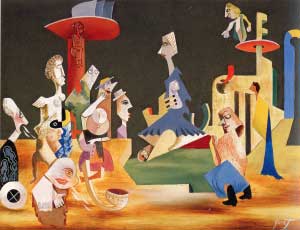
Anti-Poverty
Obeisance to Poverty
by Walter Quirt
Quirt, a member of the American Artists’ Congress, began this surrealist painting in the year the Congress first met. Quirt is criticizing the tendency of the public to romantically “elevate” and praise the poverty-stricken mothers who manage to keep their families together.
It would be harder, but ultimately more helpful, if the public and leaders instead fought to solve the problems at the root of poverty. The mother and child at the center of the image represent both poverty and the Christian Madonna and child, while the figures on the left represent various religious leaders.
|
 |
 Learn more about this artist: Learn more about this artist: |
|
|
 |
|
|
 |
Walter Quirt, Obeisance to Poverty, 1936/38. Oil on gessoed panel, 11 ¾ x 15 ½ in.
Museum Purchase, Derby Fund, from the Philip J. and Suzanne Schiller Collection of American Social Commentary Art 1930-1970.
|
|
|
|
|